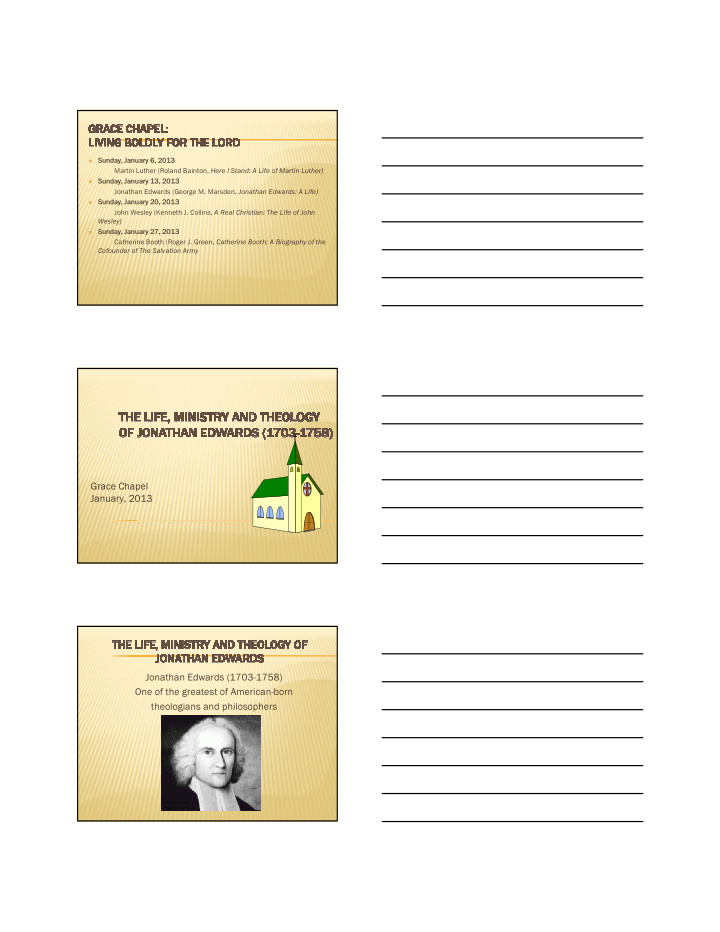



� Sunday, January 6, 2013 Martin Luther (Roland Bainton, Here I Stand: A Life of Martin Luther) � Sunday, January 13, 2013 Jonathan Edwards (George M. Marsden, Jonathan Edwards: A Life) � Sunday, January 20, 2013 John Wesley (Kenneth J. Collins, A Real Christian: The Life of John Wesley) � Sunday, January 27, 2013 Catherine Booth (Roger J. Green, Catherine Booth: A Biography of the Cofounder of The Salvation Army Grace Chapel January, 2013 Jonathan Edwards (1703-1758) One of the greatest of American-born theologians and philosophers
East Windsor Connecticut � Fluent in Latin, Greek and Hebrew � Wrote about the natural sciences— demonstrating this power of observation � Was interested in philosophy and theology � Entered Yale University when he was not yet 13 years old! YALE UNIVERSITY WETHERSFIELD CHURCH
His view of science: Concerned about faith in reason alone Laws of nature are derived from God— demonstrate his wisdom and love � Argued for: The theology of John Calvin The theology of the Puritans � Argued against: The theology of Jacob Arminius Deism—a rationalistic theology Personal Narrative —described his conversion experience: “On January 12, 1723 I made a solemn dedication of myself to God; and wrote it down; giving up myself and all that I had to God; to be for the future, in no respect, my own; to act as one that had no right to himself in any respect.”
Northampton, Massachusetts Solomon Stoddard (1643-1729)—grandfather of Jonathan Edwards � Married Sarah Pierpont (1709-1758) � 11 children � Life in the study—thirteen hours per day � Owned slaves � Preaching ministry—a scholar/pastor
The First Great Awakening 1734 A Faithful Narrative of the Surprising Work of God in the Conversion of Many Hundred Souls in Northampton (1737)” Theodore J. Frelinghuysen (1691-1748)
� Gilbert Tennent (1703-1764) � William Tennent � The “Log College” � Became Princeton University in 1746 (first named the College of New Jersey at Princeton) � George Whitefield (1714-1770) � Newburyport, Massachusetts George Whitefield Preaching
George Whitefield Preaching in the Open Air � Division in some denominations; e.g. Presbyterians—New Side Party and Old Side Party � Charles Chauncy (1705-1787)—Pastor of Boston’s First Church, Congregational � Opposition within Universities—e.g. Harvard and Yale � Resurgence of Calvinism � Revival of experiential piety � Major test for religious life—personal conversion � Stimulated concern for higher education: � Princeton—1746 (Presbyterian) � Rhode Island College (Brown University)—1764 (Baptist) � Queen’s College (Rutgers)—1766 (Dutch Reformed) � Dartmouth—1769 (Congregational)
� Elevation of the common person � Lay activity stressed—new roles of leadership � Personal independence in religious life—pointed to independence in political life � Separation of Church and State � New humanitarian impulse � New forms of assembly � The sovereignty of the people critical to political office � “Considered as a social event, the Great Awakening signifies nothing less than the first stage of the American Revolution.” The Half-Way Covenant—developed from 1657 to 1662: baptism entitled one to church membership. Not strict enough for Edwards 1750 he was dismissed from the church. Stockbridge, Massachusetts
A Careful and Strict Enquiry Into the Modern Prevailing Notions of that Freedom of Will, Which is Supposed to be Essential to Moral Agency, Vertue and Vice, Reward and Punishment, Praise and Blame (1754) THE LIFE, MINISTRY AND THEOLOGY OF JONATHAN EDWARDS � Joseph Bellamy (1719 Joseph Bellamy (1719- -1790) 1790) � � Samuel Hopkins (1721 Samuel Hopkins (1721- -1803) 1803) � Jonathan Edwards, Jr. (1745- -1801) 1801) � Jonathan Edwards, Jr. (1745 � Nathaniel Emmons (1745- -1840) 1840) � Nathaniel Emmons (1745 � � Revival of Calvinism � Balance of the life of the mind and the life of the heart � An appreciation that all truth is God’s truth: the natural world; science; theology; philosophy; ethics; economics � The power of preaching from the Scriptures
� Vice President Aaron Burr � Scores of Clergymen � Thirteen presidents of higher learning � Sixty-five professors
Recommend
More recommend